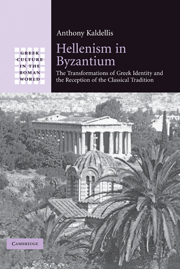 Hellenism in Byzantium
Hellenism in Byzantium PART II - HELLENIC REVIVALS IN BYZANTIUM
Published online by Cambridge University Press: 24 December 2009
Summary
At the turn of the first millennium the empire of New Rome was the oldest and most dynamic state in the world and comprised the most civilized portions of the Christian world. Its borders, long defended by native frontier troops, were being expanded by the most disciplined and technologically advanced army of its time. The unity of Byzantine society was grounded in the equality of Roman law and a deep sense of a common and ancient Roman identity; cemented by the efficiency of a complex bureaucracy; nourished and strengthened by the institutions and principles of the Christian Church; sublimated by Greek rhetoric; and confirmed by the passage of ten centuries. At the end of the reign of Basileios II (976–1025), the longest in Roman history, its territory included Asia Minor and Armenia, the Balkan peninsula south of the Danube, and the southern regions of both Italy and the Crimea. Serbia, Croatia, Georgia, and some Arab emirates in Syria and Mesopotamia had accepted a dependent status.
The empire was never again to be as powerful in the five centuries that yet remained to it, though its decline was neither steady nor inexorable. Crisis invigorated the sources of Roman strength and catastrophe was usually followed by decades of resurgence. The Komnenoi (1081–1185) largely reversed the decline of the late eleventh century and the Laskarids founded a resilient and even expansionist state at Nikaia that managed to reclaim the capital from the aggressors of 1204.
- Type
- Chapter
- Information
- Hellenism in ByzantiumThe Transformations of Greek Identity and the Reception of the Classical Tradition, pp. 189 - 190Publisher: Cambridge University PressPrint publication year: 2008
